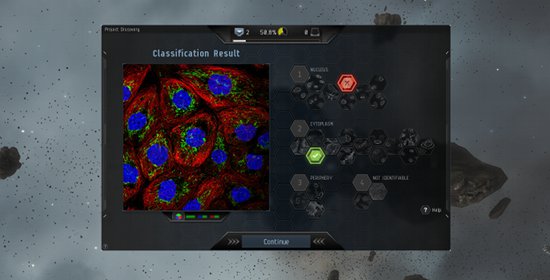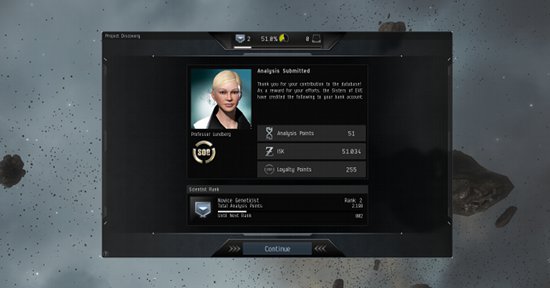Difference between revisions of "Project Discovery: Human Protein Atlas"
(→What You Get Out of It: Removed thumbnail, added Analysis Kredit redemption) |
m (Corrected: Analysis Kredits, not Loyalty Kredits ; added tip section) |
||
| Line 2: | Line 2: | ||
=What is Project Discovery= | =What is Project Discovery= | ||
| − | Project Discovery is a "citizen science", participation in scientific research by the lay community, project within EVE Online. A collaboration between CCP Games, Reyjavik University, the Human Protein Atlas, and Massively Multiplayer Online Science, it is used to characterize the structures of cells, using your identification skills, and will help scientists identify proteins within human cells. A brief tutorial and introduction to mechanics is present in the game.<br> | + | Project Discovery is a "citizen science", participation in scientific research by the lay community, project within EVE Online. A collaboration between CCP Games, Reyjavik University, the Human Protein Atlas, and Massively Multiplayer Online Science, it is used to characterize the structures of cells, using your identification skills, and will help scientists identify proteins within human cells. Because of this, playing Project Discovery helps scientists understands how human cells are built. <br> |
| + | A brief tutorial and introduction to mechanics is present in the game.<br> | ||
In-game, the [[Sisters_of_Eve|Sisters of EVE]] run Project Discovery for capsuleers to assist in identification of [[Drifters|Drifter]] biological samples. | In-game, the [[Sisters_of_Eve|Sisters of EVE]] run Project Discovery for capsuleers to assist in identification of [[Drifters|Drifter]] biological samples. | ||
| − | In addition to the above scientific participation and benefits, capsuleers also gain benefits within EVE Online. Each slide submitted results in a small amount of ISK - determined by your accuracy rating, with an accuracy of 50% conferring 50,000 ISK per slide, minus corporation tax - as well as Project Discovery-specific | + | In addition to the above scientific participation and benefits, capsuleers also gain benefits within EVE Online. Each slide submitted results in a small amount of ISK - determined by your accuracy rating, with an accuracy of 50% conferring 50,000 ISK per slide, minus corporation tax - as well as Project Discovery-specific Analysis Kredits with the Sisters of EVE.<br> |
| − | + | ||
| − | |||
| − | |||
| − | |||
| − | |||
<br> | <br> | ||
=Basic Mechanics= | =Basic Mechanics= | ||
| Line 21: | Line 18: | ||
* Completing the Tutorial | * Completing the Tutorial | ||
* Presentation with a new slide | * Presentation with a new slide | ||
| − | * Clicking on one or more cellular structure buttons, indicating you believe that the green | + | * Clicking on one or more cellular structure buttons, indicating you believe that the fluorescent green is identifying those structures |
* '''Submitting''' the Image | * '''Submitting''' the Image | ||
| − | * '''Feedback''' | + | * '''Feedback''' if enough other players have submitted the slide; if not, feedback won't be enabled yet |
| − | * '''Rewards''': ISK, Project Discovery Experience Points, and Sisters of EVE | + | * '''Rewards''': ISK, Project Discovery Experience Points, and Sisters of EVE Analysis Kredits ('''not''' Loyalty Points) |
<br> | <br> | ||
=What to Look For= | =What to Look For= | ||
The objective of Project Discovery slides is to identify what cellular structure(s) display a fluorescent green color. These can broadly be classified as '''within the''' [https://en.wikipedia.org/wiki/Cell_nucleus '''nucleus'''], in the cell's [https://en.wikipedia.org/wiki/Cytoplasm '''cytoplasm'''], or even outside the cell in the '''periphery'''. If none of these are met, consider classifying the slide as '''not identifiable'''. | The objective of Project Discovery slides is to identify what cellular structure(s) display a fluorescent green color. These can broadly be classified as '''within the''' [https://en.wikipedia.org/wiki/Cell_nucleus '''nucleus'''], in the cell's [https://en.wikipedia.org/wiki/Cytoplasm '''cytoplasm'''], or even outside the cell in the '''periphery'''. If none of these are met, consider classifying the slide as '''not identifiable'''. | ||
| − | |||
<br> | <br> | ||
| − | + | <br> | |
| + | Tips: | ||
| + | * Most slides presented to players have 1-2 structures highlighted with fluorescent green, though it's possible that slides may have zero green structures or 3+ green structures.<br> | ||
| + | * Cytoplasm, nucleus, and nucleolus seem to be the most frequent structures identifiable in this batch of images.<br> | ||
| + | * Remember to focus on the fluorescent green color. Consider using the filters at the bottom of the image to hide red and/or blue to make identifying the green region easier.<br> | ||
| + | |||
<br> | <br> | ||
This image demonstrates a capsuleer selected one element in the Nucleus and one element in the Cytoplasm; a majority of capsuleers agree with the cytoplasm structure choice - hence the green checkmark - but disagree with the nucleus structure choice - hence the red X.<br> | This image demonstrates a capsuleer selected one element in the Nucleus and one element in the Cytoplasm; a majority of capsuleers agree with the cytoplasm structure choice - hence the green checkmark - but disagree with the nucleus structure choice - hence the red X.<br> | ||
Revision as of 19:35, 7 April 2016
Contents
What is Project Discovery
Project Discovery is a "citizen science", participation in scientific research by the lay community, project within EVE Online. A collaboration between CCP Games, Reyjavik University, the Human Protein Atlas, and Massively Multiplayer Online Science, it is used to characterize the structures of cells, using your identification skills, and will help scientists identify proteins within human cells. Because of this, playing Project Discovery helps scientists understands how human cells are built.
A brief tutorial and introduction to mechanics is present in the game.
In-game, the Sisters of EVE run Project Discovery for capsuleers to assist in identification of Drifter biological samples.
In addition to the above scientific participation and benefits, capsuleers also gain benefits within EVE Online. Each slide submitted results in a small amount of ISK - determined by your accuracy rating, with an accuracy of 50% conferring 50,000 ISK per slide, minus corporation tax - as well as Project Discovery-specific Analysis Kredits with the Sisters of EVE.
Basic Mechanics
Project Discovery can be accessed using your NeoCom, under the Business tab. Beginning to use it is as simple as pressing this button, then this button and following the tutorial.
Its workflow consists of:
- Completing the Tutorial
- Presentation with a new slide
- Clicking on one or more cellular structure buttons, indicating you believe that the fluorescent green is identifying those structures
- Submitting the Image
- Feedback if enough other players have submitted the slide; if not, feedback won't be enabled yet
- Rewards: ISK, Project Discovery Experience Points, and Sisters of EVE Analysis Kredits (not Loyalty Points)
What to Look For
The objective of Project Discovery slides is to identify what cellular structure(s) display a fluorescent green color. These can broadly be classified as within the nucleus, in the cell's cytoplasm, or even outside the cell in the periphery. If none of these are met, consider classifying the slide as not identifiable.
Tips:
- Most slides presented to players have 1-2 structures highlighted with fluorescent green, though it's possible that slides may have zero green structures or 3+ green structures.
- Cytoplasm, nucleus, and nucleolus seem to be the most frequent structures identifiable in this batch of images.
- Remember to focus on the fluorescent green color. Consider using the filters at the bottom of the image to hide red and/or blue to make identifying the green region easier.
This image demonstrates a capsuleer selected one element in the Nucleus and one element in the Cytoplasm; a majority of capsuleers agree with the cytoplasm structure choice - hence the green checkmark - but disagree with the nucleus structure choice - hence the red X.

What You Get Out of It
Upon submission of each slide, capsuleers are rewarded with ISK, Project Discovery experience, and Analysis Kredits.
The quantity of ISK and Project Discovery experience points are determined by the pilot's accuracy rating: at an accuracy rating of 50%, pilots will accumulate 50 EXP and 50,000 ISK per slide submitted.
Ranks are a method of quantifying the pilot's contribution to Project Discovery. Rank is increased by accumulating experience points.
Analysis Kredits may be spent at Sisters of EVE Loyalty Point stores, but they are not interchangeable with Loyalty Points. Instead, Analysis Kredits are used to purchase new Project Discovery -specific items including boosters and attire.

External Links
EVE Online: Project Discovery
Developer Blog Introducing Project Discovery
EVE Flight Academy Video by Professor Lundberg